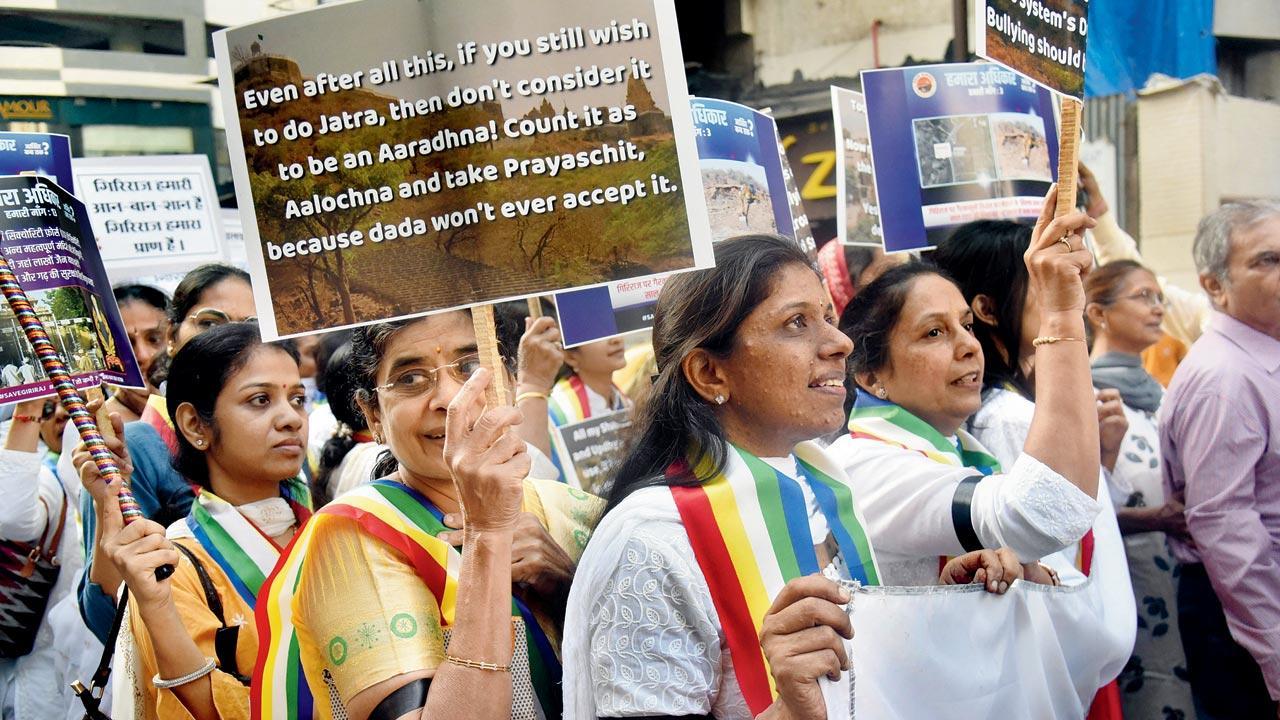Why is the peaceful Jain community protesting all around the country? They say it’s to protect the sanctity of their religious sites

Shri Mumbai Jain Sangh Sangathan organised the rally on January 1 , in Mumbai. The body says more than a lakh people participated. File pic/Sameer Markande
When most people were celebrating the new year with a festive fervour, the Jain community was in solemn mode. They had taken to the streets to dissent the Jharkhand government’s decision to promote their pilgrimage site, Sammed Shikharji, as a tourist destination; and in protection of Shetrunjaya Hills in Bhavnagar, Gujarat, home to another holy site, Palitana.
ADVERTISEMENT
Both sites are supremely important to the religion. Palitana is said to hold more than 900 Jain temples, while Shikharji is their Mecca—20 out of 24 thirthankars are said to have achieved salvation here. It has 31 tonks (peaks with temples), each containing shrines and footprints of the thirthankars. They date back centuries and some of them were rebuilt in 1768 CE. The community fears rampant illegal mining in the area would create a natural disaster like the one in Joshimath.
“Every Jain is taken to Palitana by their parents within the first six months of their birth,” says Kamlesh Shah, an executive committee member of Mumbai Jain Sanghatan. “Thus, there is a sense of attachment [with Palitana].” Protestors believe that anti-social elements and land encroachment threaten its sanctity.
 Nitin Vora and Kamlesh Shah
Nitin Vora and Kamlesh Shah
The community says they have drawn attention to both issues several times over the past year, but no action has been taken by authorities. A 72-year-old monk, Sugyeysagar Maharaj, went on hunger strike at Sanghiji Temple in Jaipur to oppose the Shikharji decision; he has since passed away. Now they say they have no option but to show strength in numbers.
“Illegal encroachment of forest land on and around Shetrunjaya hills, spread across 8,800 acres,” says Nitin Vora, trustee of Mumbai Jain Sangathan, as he lists off their complaints, “illegal sale and purchase of the tirth land, dismantling of the structure that marks the footsteps of tirthankar Aadinath Bhagwan, vandalisation of CCTV cameras at the temples, ‘mafiagiri’ by contractors in the pilgrim site, and poor maintenance of roads and drainage system.” A protest rally had “spontaneously” gathered in Palitana on 18 December, 2022, to raise these issues.
“It was completely self-motivated,” says Kamlesh, who is also a trustee of Vardhman Parivar, a Jain charitable trust. “Within 24 hours, around 25,000 people from all around the country reached Palitana. There were protests in Shikharji in July and August last year, and smaller rallies in Palitana in the first week of December. It picked up at other cities in January.” A Gujarati mid-day reporter, Ruchita Shah, who covered the Palitana march on-ground, said that despite the numbers, it was one of the most peaceful protests she had seen.
 Harsh Shah and Viraj Dhulla
Harsh Shah and Viraj Dhulla
“This is a result of four to five years of pent up anger,” says Harsh Shah, trustee of Shetrunjay Yuvak Mandal. He has reasons to believe there is production and consumption of illegal alcohol in the areas around the pilgrim site. Ruchita, who covered the area for five days, says a village close-by has a high number of women, in the age group of 30 to 40 years, widowed by alcoholism. She confirmed that hooch production and consumption was widespread.
Harsh is dismayed that the issue is being given a Hindu versus Jain spin. “The community has filed complaints to the collector and mining authorities in the last two years. A rumour has been spread that one of the temples at Palitana does not belong to the Jain community. A case filed by a monk, under the “fake name” Kalu Bharti, and organisation in 2014, reached the Gujarat High Court. In 2021, it was decided that since the community was looking after the temple for decades, it would continue to do so.” He says goons hired by land sharks in the area have been stirring mistrust against the Jain community, turning one community against another. “The main issues of production and consumption of alcohol, illegal mining, encroachment, harassment of devotees were diverted by pitting Hindus against Jains,” adds Harsh.
One unique facet of the recent mass display of dissent has been the presence of youth. “Many community groups went from [housing] society to society in Mulund, urging young people to participate,” says a 28-year-old advertising professional. Mulund-based Viraj Dhulla, founder KDO Classic (youth wing of Kutchi Dasa Oswal), was one of them. “The atmosphere was different,” says the 38-year-old adding, “for the first time Jains, who have never protested, came together over an issue. This is not just about the older generation. It’s important that all generations come together. That is when we know our strength.” “The Jain youth don’t usually take up these issues,” adds Harsh. “They came in the hope of democratic justice.” He spends two days in Palitana every week. As a trustee of a youth organisation, Harsh says he gets 40 to 50 messages each week from young people, asking what to do next.
The community is not in complete opposition to government plans: it understands that turning Shikharji into a tourist destination would create more employment opportunities. However, “Jains run the economy there,” explains Kamlesh. “The place has been venerated for centuries; every particle is sacred, which will be destroyed if it becomes a tourist spot. The sacred place of any religion or community should be preserved.” Harsh suggests Shikharji be “developed like the Amritsar model, for spiritual tourism.” The community also isn’t against the Jharkhand government turning Sammed Shikharji into an eco-sensitive spot, as long as they are allowed to carry out construction and repair work on their ancient temples.
Harsh believes that every place and institution has its own code of conduct and rules. If an institute such as a hospital, office, and hotel have its own rules, why can’t a religious place such as Palitana and Shikharji? “The community has proposed an 18-point letter and a task force has been appointed to look into it,” says DK Parekh, Collector of Bhavnagar. “Currently, they have had two meetings and the decision is on the way for issues such as illegal mining, encroachment, selling and consumption of alcohol, consumption and sale of meat. The quick response team, with officials from different sectors, will be looking into this for immediate action.”
 Subscribe today by clicking the link and stay updated with the latest news!" Click here!
Subscribe today by clicking the link and stay updated with the latest news!" Click here!








